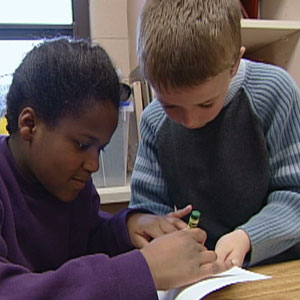Join us for conversations that inspire, recognize, and encourage innovation and best practices in the education profession.
Available on Apple Podcasts, Spotify, Google Podcasts, and more.
 “Children are natural scientists, and they ask a lot of great questions. They’re not intimidated. I think as we grow older, we become intimidated, and we’re afraid what people will think of us if we ask certain questions, or if we give certain answers. Children are not afraid of that.”
“Children are natural scientists, and they ask a lot of great questions. They’re not intimidated. I think as we grow older, we become intimidated, and we’re afraid what people will think of us if we ask certain questions, or if we give certain answers. Children are not afraid of that.”
In college, Laurie Wicks abandoned her pursuit of a degree in elementary education for one in business economics, which is how she started her first career at one of the major banks in Wilmington, Delaware working with, as she puts it, “adults.” “Even when I was majoring in economics, I took all my electives in education — there was just a love there,” explains Wicks. And so, while engaged in her “second career” — staying at home with her children for a few years — she worked to become certified for her third. Laurie is now in her eighth year in the classroom, and fifth year teaching third grade.
Laurie shares two homerooms with a partner, and the two of them have developed what she calls a theme-based instruction program. The two select a theme, and then center all math, science, English, and social studies instruction around it. “We’ve invented the particular schedule and method,” explains Laurie, “and as far we know, there ’s nobody across the country doing exactly what we do.”
 Lesson at a Glance:
Lesson at a Glance:
Curriculum: FOSS
Grade: Third
Topic: Rocks
The theme of the lesson that Laurie’s third graders worked on was that rocks tell stories. Working with the Earth materials kit from the FOSS curriculum, which Laurie says has a strong focus on hands-on activities, the children looked at a number of rocks that contained fossils, and tried to decide what stories those rocks were telling them.
The video features the second day of a two-day lesson. On the first day, Laurie distributed the rocks and asked her students to imagine that they are geologists and have just received a new, fascinating sample. She asked them what they would do as scientists to analyze this fossil and rock. The children took their work seriously, taking measurements, examining their rock’s properties, studying the fossil, and taking rubbings of it. “They came up with some rather fascinating things, experiments they wanted to perform,” Laurie said after the lesson.
In day two of the lesson, Laurie had her students think about the data they collected the previous day, and asked them to do research to determine what kind of rock and fossil were in their samples. “Hopefully they have enough research materials between the Internet and research books that they will try and use the data that they compiled to match to their fossil and to figure out what type of fossil it is, and hopefully what kind of rock also.”
Laurie hopes the students learn to be self-reliant when they’re exploring their world: “If they can walk away this year and feel good that they can do this independently, that they don’t feel intimidated when asked a question, that they know where to go to find answers, not to go always to people, but how they can start investigating something on their own. That ’s all we need.”